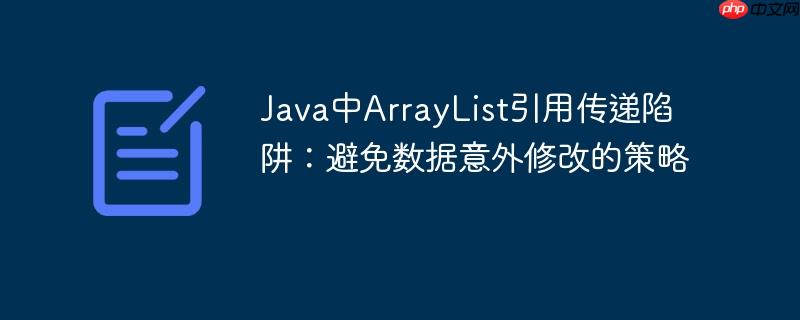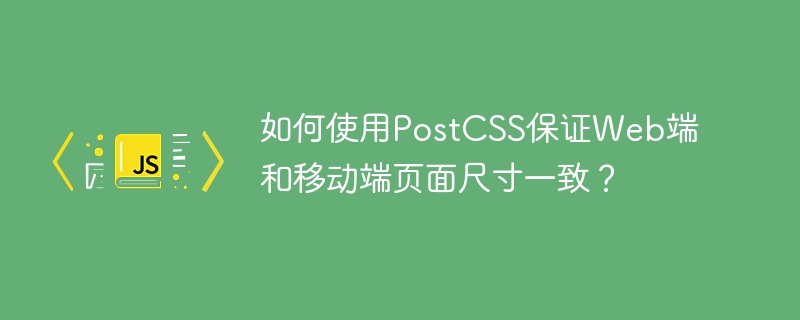
本文探讨了Java中ArrayList作为引用类型在对象构造时可能导致的数据意外修改问题。当将同一个ArrayList实例传递给多个对象后,对该列表的后续操作(如清空或添加元素)会影响所有引用它的对象。核心解决方案是为每个需要独立数据副本的对象,实例化一个新的ArrayList,从而确保数据隔离和一致性。
1. 理解Java中的引用传递机制
在java中,对象(包括arraylist)是通过引用传递的。这意味着当你将一个arraylist实例传递给一个方法或构造函数时,你传递的并不是列表内容的副本,而是指向内存中同一arraylist对象的引用。如果多个对象持有同一个arraylist的引用,那么对该arraylist的任何修改都会反映在所有持有其引用的对象中。
考虑以下场景:一个Question类在其构造函数中接受一个ArrayList<String>作为其选项。
public class Question { private String genre; private String questionText; private ArrayList<String> choices; // 存储选项 private String answer; private String funFact; public Question(String genre, String questionText, ArrayList<String> choices, String answer, String funFact) { this.genre = genre; this.questionText = questionText; this.choices = choices; // 这里是关键:直接引用传入的列表 this.answer = answer; this.funFact = funFact; } public ArrayList<String> getChoices() { return choices; } // ... 其他getter方法 }
当外部代码创建Question对象并传入一个ArrayList时,Question对象内部的choices字段将直接指向外部传入的那个ArrayList实例。
2. 问题示例与分析
以下代码片段展示了由于共享ArrayList引用而导致的数据意外修改问题:
public static ArrayList<Question> allInitialQuestions(ArrayList<Question> q) { ArrayList<String> c = new ArrayList<>(); // 声明一个ArrayList用于存储选项 // 第一个问题:地理 - 海洋 c.add("Pacific"); c.add("Atlantic"); c.add("Arctic"); c.add("Indian"); q.add(new Question("Geography", "Which ocean is the largest?", c, "Pacific", "The Pacific Ocean stretches to an astonishing 63.8 million square miles!")); // 问题所在:清空并重用同一个ArrayList实例 c.removeAll(c); // 清空了'c',也清空了第一个Question对象内部的choices列表! // 第二个问题:地理 - 国家数量 c.add("192"); c.add("195"); c.add("193"); c.add("197"); q.add(new Question("Geography", "How many countries are in the world?", c, "195", "Africa has the most countries of any continent with 54.")); // ... 更多类似操作 return q; }
问题分析:
立即学习“Java免费学习笔记(深入)”;
在上述代码中,ArrayList<String> c被声明并初始化了一次。当第一个Question对象被创建时,它内部的choices字段获得了对c的引用。紧接着,c.removeAll(c)操作清空了c中的所有元素。由于第一个Question对象和外部的c变量引用的是同一个ArrayList实例,所以当c被清空时,第一个Question对象内部的选项列表也随之被清空了。随后向c中添加的新选项,又会出现在所有引用c的Question对象中,导致数据混乱。
简而言之,所有通过c创建的Question对象都共享同一个ArrayList实例,因此对c的任何修改都会影响到所有这些Question对象。
3. 解决方案:每次实例化新的ArrayList
解决这个问题的关键在于确保每个Question对象都拥有其选项列表的独立副本。最直接有效的方法是,在为每个Question对象准备选项时,都实例化一个新的ArrayList。
public static ArrayList<Question> allInitialQuestions(ArrayList<Question> q) { // 第一个问题:地理 - 海洋 ArrayList<String> c1 = new ArrayList<>(); // 为第一个问题创建新的ArrayList c1.add("Pacific"); c1.add("Atlantic"); c1.add("Arctic"); c1.add("Indian"); q.add(new Question("Geography", "Which ocean is the largest?", c1, "Pacific", "The Pacific Ocean stretches to an astonishing 63.8 million square miles!")); // 第二个问题:地理 - 国家数量 ArrayList<String> c2 = new ArrayList<>(); // 为第二个问题创建新的ArrayList c2.add("192"); c2.add("195"); c2.add("193"); c2.add("197"); q.add(new Question("Geography", "How many countries are in the world?", c2, "195", "Africa has the most countries of any continent with 54.")); // ... 更多问题,每次都创建新的ArrayList ArrayList<String> c3 = new ArrayList<>(); c3.add("Mississippi"); c3.add("Nile"); c3.add("Congo"); c3.add("Amazon"); q.add(new Question("Geography", "What is the name of the longest river in the world?", c3, "Nile","Explorer John Hanning Speke discovered the source of the Nile on August 3rd, 1858.")); ArrayList<String> c4 = new ArrayList<>(); c4.add("United States"); c4.add("China"); c4.add("Japan"); c4.add("India"); q.add(new Question("Geography","Which country has the largest population?" ,c4, "China", "Shanghai is the most populated city in China with a population of 24,870,895.")); ArrayList<String> c5 = new ArrayList<>(); c5.add("Mars"); c5.add("Mercury"); c5.add("Venus"); c5.add("Jupiter"); q.add(new Question("Geography","Which planet is closest to Earth?",c5,"Venus","Even though Venus is the closest, the planet it still ~38 million miles from Earth!")); ArrayList<String> c6 = new ArrayList<>(); c6.add("Sega"); c6.add("Nintendo"); c6.add("Sony"); c6.add("Atari"); q.add(new Question("Video Games", "Which company created the famous plumber Mario?", c6, "Nintendo", "Nintendo created Mario in 1981 for the arcade game Donkey Kong.")); ArrayList<String> c7 = new ArrayList<>(); c7.add("Sonic"); c7.add("Tales"); c7.add("Knuckles"); c7.add("Amy"); q.add(new Question("Video Games", "What is the name of the famous video character who is a blue hedgehog?",c7,"Sonic", "In some official concept art, Sonic was originally meant to be a rabbit.")); ArrayList<String> c8 = new ArrayList<>(); c8.add("Wii Sports"); c8.add("Grand Theft Auto V"); c8.add("Tetris"); c8.add("Minecraft"); q.add(new Question("Video Games","As of 2022, which of the following is the best selling video game of all time?",c8,"Minecraft","As of 2022, Minecraft has sold over 238 million units.")); return q; }
工作原理: 通过为每个Question对象创建独立的ArrayList实例(例如c1, c2等),每个Question对象都将持有其自己独立的选项列表的引用。这样,对一个列表的修改将不会影响到其他列表,从而确保了数据的隔离和正确性。
4. 进阶考量与最佳实践
在处理集合类数据时,除了实例化新列表,还有其他一些最佳实践可以考虑:
-
防御性复制 (Defensive Copying): 如果你的Question类构造函数接受一个外部传入的ArrayList,但你希望确保该Question对象内部的列表不受外部修改的影响,可以在构造函数内部进行防御性复制。
public class Question { // ... private ArrayList<String> choices; public Question(String genre, String questionText, ArrayList<String> choices, String answer, String funFact) { // ... this.choices = new ArrayList<>(choices); // 创建传入列表的副本 // ... } // ... }这样,即使外部传入的choices列表在Question对象创建后被修改,Question对象内部的choices列表也不会受到影响。
-
不可变集合 (Immutable Collections): 如果Question对象的选项列表在创建后不应该被修改,可以考虑使用不可变集合。Java的Collections工具类提供了Collections.unmodifiableList()方法,可以返回一个不可修改的列表视图。
public class Question { // ... private final List<String> choices; // 使用List接口,并声明为final public Question(String genre, String questionText, List<String> choices, String answer, String funFact) { // ... // 先进行防御性复制,再包装成不可修改的列表 this.choices = Collections.unmodifiableList(new ArrayList<>(choices)); // ... } public List<String> getChoices() { // 返回不可修改的列表视图 return choices; } // ... }这样做可以防止外部代码意外或恶意地修改Question对象的选项列表,增强了对象的封装性和数据安全性。
-
代码清晰度与维护性: 明确地实例化新的ArrayList实例,或者使用防御性复制,都能使代码的意图更加清晰。这有助于其他开发者理解数据的生命周期和所有权,从而降低未来维护的复杂性。
总结
在Java中处理ArrayList等引用类型时,理解引用传递的语义至关重要。当将一个ArrayList实例传递给多个对象时,它们将共享同一个底层数据结构。为了避免数据意外修改和维护数据独立性,我们应根据具体需求选择合适的策略:
- 最直接的解决方案:在每次需要独立数据集合时,显式地实例化一个新的ArrayList。
- 增强封装性:在对象构造函数内部进行防御性复制,确保对象内部状态不受外部传入引用的影响。
- 确保数据不变性:如果列表内容不应被修改,使用Collections.unmodifiableList()创建不可变列表视图。
通过采纳这些实践,开发者可以有效地管理ArrayList等引用类型的数据,构建出更健壮、更易于维护的java应用程序。


















